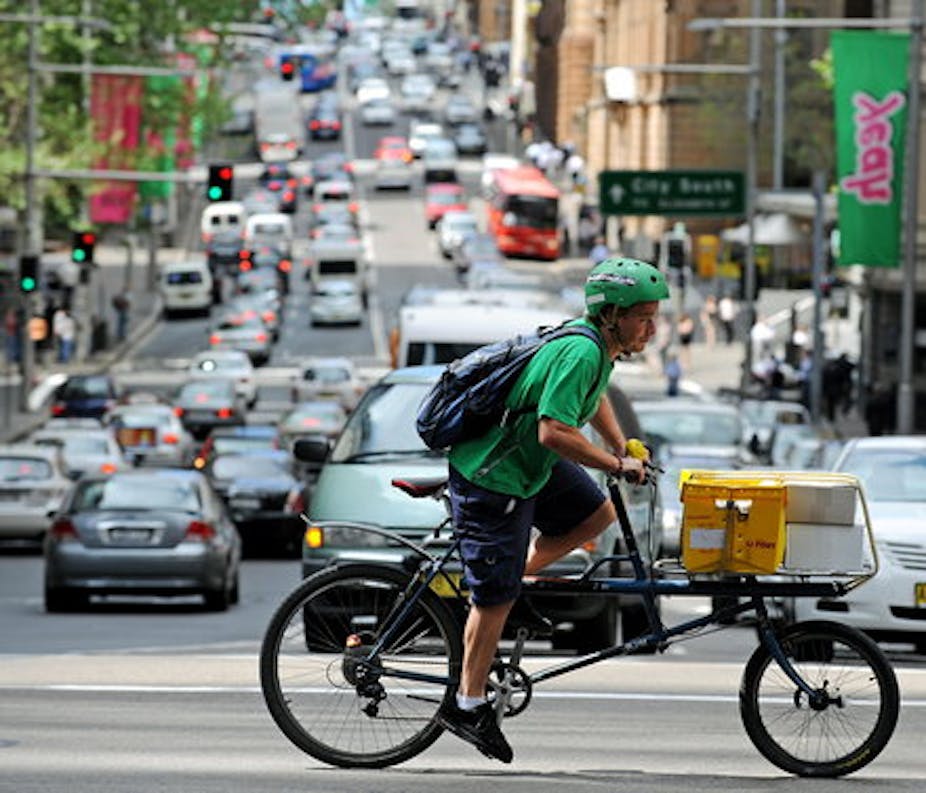Both Ross Garnaut and Ken Henry have spoken out against the Fringe Benefits Tax concession for company cars, pointing to it as an incentive for us to drive more.
Indeed some would say that it is just one of many ways the government supports use of private motor vehicles over less-polluting, but more difficult alternatives: better designed cities coupled with integrated low impact public transport systems.
Propping up the vehicle industry…
There does appear to be a bias towards the production, purchase and use of passenger vehicles in Australia.
Passenger vehicles enjoy a range of preferential treatments. These range from the direct and indirect support of the production and importation of vehicles that use fossil fuel, through to tax concessions for all kinds of motor vehicle use.
One recent estimate of subsidies granted to road transport is $4.49 billion for the fiscal year, 2001 to 2002 (Reidy, C., 2003, Subsidies that encourage fossil fuel use in Australia).
It is unlikely that the magnitude of this subsidy will have changed appreciably over the period through to 2011.
Tariffs are a particularly telling aspect of the Australian automotive industry.
Over the last ten years Australian Governments have attempted to wean the Australian automotive industry off tariff protection (tariffs were reduced from 15% to 10% in January 2005 and then to 5% in 2010). But the major players in this industry have been able to negotiate generous assistance packages through the Automotive Competitiveness and Investment Scheme (ACIS) through to 2020.
Surprisingly, each of the motor vehicle producers who are covered by the scheme also import large numbers of motor vehicles to Australia. It is these companies in particular that have been slow in introducing viable fuel efficient vehicles into the Australian market.
…and wanting to reduce emissions
Our sprawling cities, marked by suburbs with access to highways and little or no public transport ensure that privately owned motor vehicles will be a necessity for some time to come.
Emissions from motor vehicles are a major source of greenhouse gases. In 2005 we owned 10.9 million passenger vehicles; in 2010 it was 12.3 million. Virtually all of these vehicles rely on petrol.
More generally, the number of motor vehicles per 1,000 resident population has increased from 686.3 at the end of March 2005 to 721.1 at the end of March 2010. That means we have more cars each.
No doubt, many of these new vehicles are small, fuel-efficient cars but there is also a considerable number of large gas-guzzling four wheel drive vehicles that have been added to the Australian passenger vehicle fleet.
This rate of growth seems inconsistent with government calls for us to reduce greenhouse emissions.
It would appear that if we do nothing to reduce greenhouse gas emissions then by 2020 emissions will be close to 150% of the 2010 emissions, with much of this increase accounted for by the passenger car fleet.
It is often argued that Australia does not need to be concerned with greenhouse gas emissions because it is just a small contributor.
This argument ignores the other effects of air pollution. Most Australians live in large cities and many of them suffer from the effects of pollution created by motor vehicles.
A 150% increase in emissions from motor vehicles will inevitably degrade the air quality in our major cities. This will have an adverse impact on critical industries like tourism and education as well as placing further burden on a stretched health industry.
Will anything stop us driving?
Increases in the cost of petrol are unlikely to have much impact on the use of passenger vehicles for the daily commute to work while the alternatives such as trains and buses are crowded or non-existent.
Many Australians who live in the suburbs and work in the city have little choice but to rely on passenger vehicles for their transport needs.
Should we consider reforming the present complex web of regulations and legislation that fosters and supports the continued increases in passenger motor vehicle use, particularly where the motor vehicles are large, heavy and use excessive amounts of fuel?
The need to change to alternative fuels seems indisputable but these alternatives are costly and politically difficult.
It will be interesting to see whether the introduction of a carbon tax will be sufficient to swing the balance away from greenhouse gas polluting motor vehicles towards alternatives that ensure a cleaner environment for future generations of Australians.
Will Australians actually start to think about whether to drive or not to drive?

